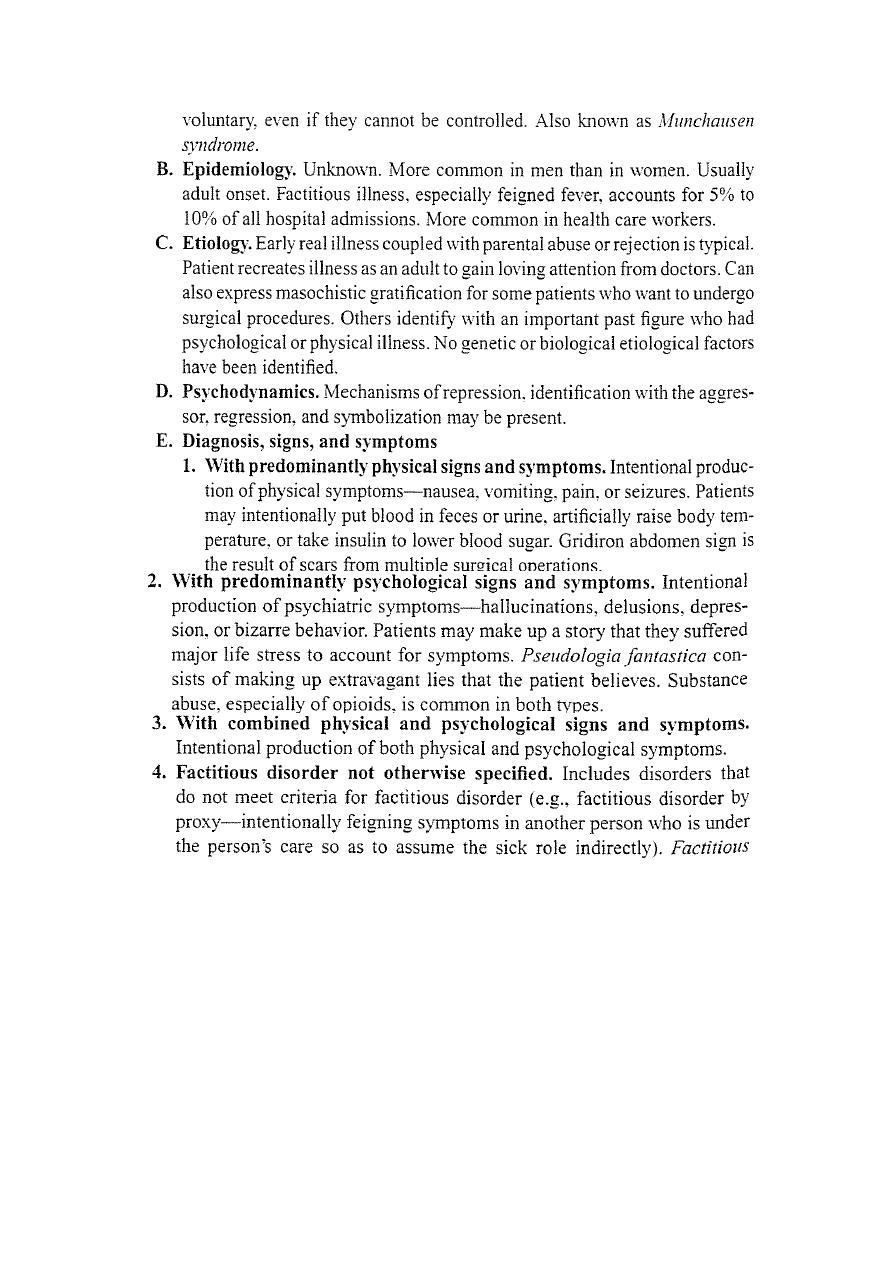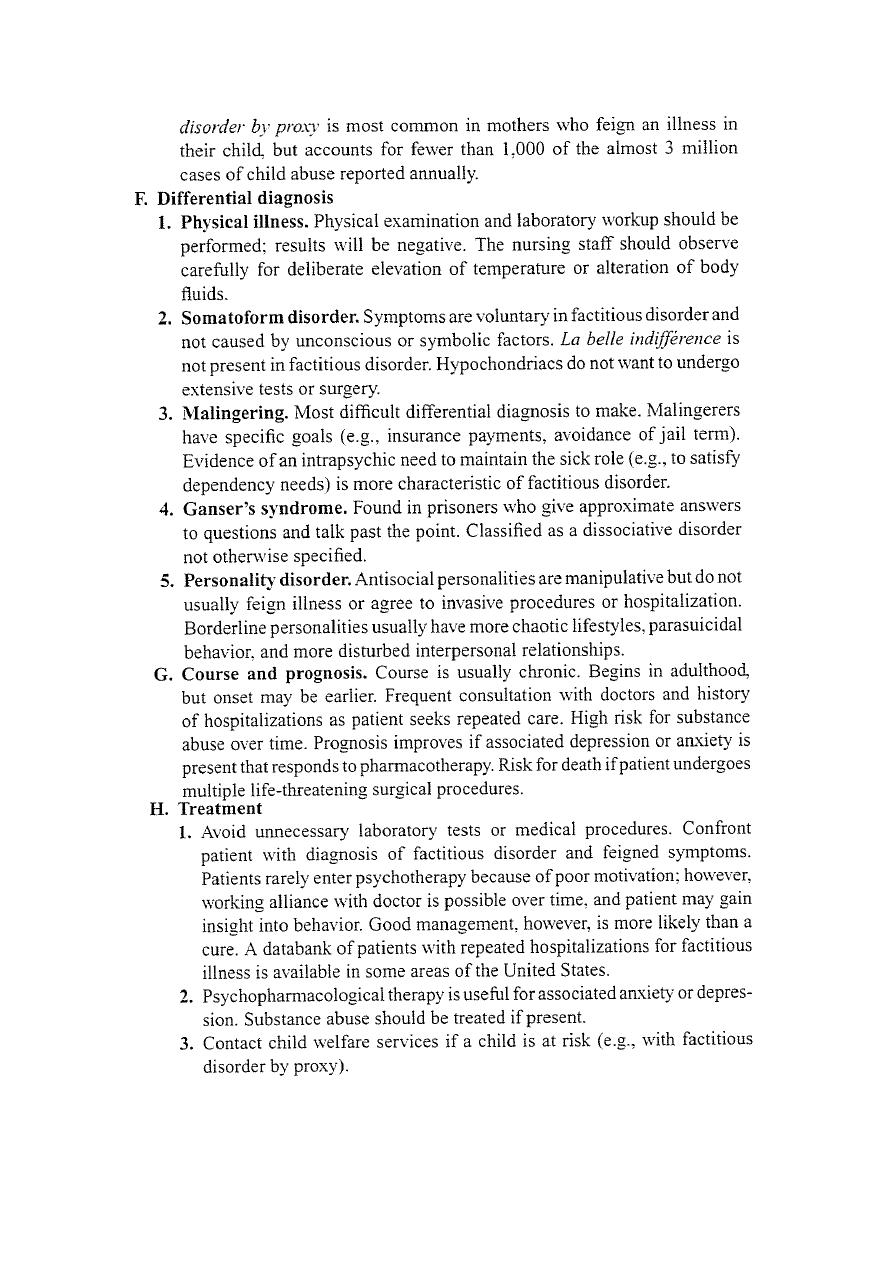
`Somatic Symptom and Related Disorders د.وليد عزيز العميدي
Classification according to DSM-V :
- Somatic Symptom Disorder.
- Illness Anxiety Disorder.
- Functional Neurological Symptom Disorder.
- Psychological Factors Affecting Other Medical Conditions.
- Factitious Disorder.
- Other Specified Somatic Symptom and Related Disorder.
Somatic Symptom Disorder
:
Somatic symptom disorder, also known as
hypochondriasis, is characterized by 6 or more months of a general and non
delusional preoccupation with fears of having, or the idea that one has, a serious
disease based on the person’s misinterpretation of bodily symptoms. This
preoccupation causes significant distress and impairment in one’s life; it is not
accounted for by another psychiatric or medical disorder.
EPIDEMIOLOGY : Men and women are equally affected by this disorder. Although
the onset of symptoms can occur at any age, the disorder most commonly appears in
persons 20 to 30 years of age.
ETIOLOGY : Persons with this disorder augment and amplify their somatic
sensations; they have low thresholds for, and low tolerance of, physical
discomfort. For example, what persons normally perceive as abdominal pressure,
persons with somatic symptom disorder experience as abdominal pain. They may
focus on bodily sensations, misinterpret them, and become alarmed by them because
of a faulty cognitive scheme.
DIAGNOSIS :
According to the fifth edition of Diagnostic and Statistical Manual of
Mental Disorders (DSM-5), the diagnostic criteria for somatic symptom
disorder require that patients be preoccupied with the false belief that they have a
serious disease, based on their misinterpretation of physical signs or sensations . The
belief must last at least 6 months, despite the absence of pathological findings on
medical and neurological examinations. The diagnostic criteria also require that the
belief cannot have the intensity of a delusion (more appropriately diagnosed as
delusional disorder) and cannot be restricted to distress about appearance (more
appropriately diagnosed as body dysmorphic disorder). The symptoms of somatic
symptom disorder must be sufficiently intense to cause emotional distress or impair
the patient’s ability to function in important areas of life.
COURSE AND PROGNOSIS : The course of the disorder is usually episodic; the
episodes last from months to years and are separated by equally long quiescent
periods. There may be an obvious association between exacerbations of somatic
symptoms and psychosocial stressors. A good prognosis is associated with high
socioeconomic status, treatment-responsive anxiety or depression, sudden onset of
symptoms, the absence of a personality disorder, and the absence of a related non
psychiatric medical condition
TREATMENT : Patients with somatic symptom disorder usually resist psychiatric
treatment, although some accept this treatment if it takes place in a medical setting
and focuses on stress reduction and education in coping with chronic illness.
- Group psychotherapy often benefits such patients, in part because it provides
the social support and social interaction that seem to reduce their anxiety.

Other forms of psychotherapy, such as behavior therapy, cognitive therapy,
and hypnosis, may be useful.
- Frequent, regularly scheduled physical examinations help to reassure patients
that their physicians are not abandoning them and that their complaints are
being taken seriously.
- Pharmacotherapy alleviates somatic symptom disorder only when a patient has
an underlying drug-responsive condition, such as an anxiety disorder or
depressive disorder.
Illness Anxiety Disorder : Illness anxiety disorder is a new diagnosis in the (DSM-5)
that applies to those persons who are preoccupied with being sick or with developing
a disease of some kind. It is a variant of somatic symptom disorder (hypochondriasis)
. As stated in DSM-5: Most individuals with hypochondriasis are now classified as
having somatic symptom disorder; however, in a minority of cases, the diagnosis of
illness anxiety disorder applies instead. In describing the differential diagnosis
between the two, according to DSM-5, somatic symptom disorder is diagnosed when
somatic symptoms are present, whereas in illness anxiety disorder, there are few or no
somatic symptoms and persons are “primarily concerned with the idea they are ill.”
DIAGNOSIS
The major DSM-5 diagnostic criteria for illness anxiety disorder are that patients be
preoccupied with the false belief that they have or will develop a serious disease and
there are few if any physical signs or symptoms . The belief must last at least 6
months, and there are no pathological findings on medical or neurological
examinations. The belief cannot have the fixity of a delusion (more appropriately
diagnosed as delusional disorder) and cannot be distress about appearance (more
appropriately diagnosed as body dysmorphic disorder). The anxiety about illness must
be incapacitating and cause emotional distress or impair the patient’s ability to
function in important areas of life.
TREATMENT
As with somatic symptom disorder .
Functional Neurological Symptom Disorder (Conversion Disorder):
Conversion disorder, also called functional neurological symptom disorder in the
Diagnostic and Statistical Manual of Mental Disorders, fifth edition (DSM-5), is an
illness of symptoms or deficits that affect voluntary motor or sensory functions, which
suggest another medical condition, but that is judged to be caused by psychological
factors because the illness is preceded by conflicts or other stressors. The
symptoms or deficits of conversion disorder are not intentionally produced, are not
caused by substance use, are not limited to pain or sexual symptoms, and the gain is
primarily psychological and not social, monetary, or legal.
The syndrome currently known as conversion disorder was originally combined with
the syndrome known as somatization disorder and was referred to as hysteria,
conversion reaction, or dissociative reaction. Paul Briquet and Jean-Martin Charcot
contributed to the development of the concept of conversion disorder by noting the
influence of heredity on the symptom and the common association with a
traumatic event. The term conversion was introduced by Sigmund Freud, who
hypothesized that the symptoms of conversion disorder reflect unconscious conflicts.
EPIDEMIOLOGY
Several studies have reported that 5 to 15 percent of psychiatric consultations in a
general hospital involve patients with conversion disorder diagnoses. The ratio of

women to men among adult patients is at least 2 to 1. Symptoms are more common on
the left than on the right side of the body in women. Women who present with
conversion symptoms are more likely subsequently to develop somatization disorder
than women who have not had conversion symptoms. An association exists between
conversion disorder and antisocial personality disorder in men. Men with conversion
disorder have often been involved in occupational or military accidents.
ETIOLOGY
:
Psychoanalytic Factors
According to psychoanalytic theory, conversion disorder is caused by repression of
unconscious intrapsychic conflict and conversion of anxiety into a physical symptom.
The conflict is between an instinctual impulse (e.g., aggression or sexuality) and the
prohibitions against its expression.
Learning Theory
In terms of conditioned learning theory, a conversion symptom can be seen as a piece
of classically conditioned learned behavior; symptoms of illness, learned in
childhood, are called forth as a means of coping with an otherwise impossible
situation.
Biological Factors
Increasing data implicate biological and neuropsychological factors in the
development of conversion disorder symptoms. Preliminary brain imaging
studies have found hypometabolism of the dominant hemisphere and
hypermetabolism of the nondominant hemisphere and have implicated impaired
hemispheric communication in the cause of conversion disorder.
DIAGNOSIS
The DSM-5 limits the diagnosis of conversion disorder to those symptoms that affect
a voluntary motor or sensory function, that is, neurological symptoms. Physicians
cannot explain the neurological symptoms solely on the basis of any known
neurological condition. The diagnosis of conversion disorder requires that clinicians
find a necessary and critical association between the cause of the neurological
symptoms and psychological factors, although the symptoms cannot result from
malingering or factitious disorder.
CLINICAL FEATURES
Paralysis, blindness, and mutism are the most common conversion disorder
symptoms. Conversion disorder may be most commonly associated with passive-
aggressive, dependent, antisocial, and histrionic personality disorders. Depressive and
anxiety disorder symptoms often accompany the symptoms of conversion disorder,
and affected patients are at risk for suicide.
Sensory Symptoms
In conversion disorder, anesthesia and paresthesia are common, especially of the
extremities. All sensory modalities can be involved, and the distribution of the
disturbance is usually inconsistent with either central or peripheral neurological
disease. .
Motor Symptoms
The motor symptoms of conversion disorder include abnormal movements, gait
disturbance, weakness, and paralysis. Gross rhythmical tremors, choreiform
movements, tics, and jerks may be present. The movements generally worsen when
attention is called to them.

Seizure Symptoms
Pseudoseizures are another symptom in conversion disorder. Clinicians may find it
difficult to differentiate a pseudoseizure from an actual seizure by clinical observation
alone. Moreover, about one third of the patient’s pseudoseizures also have a
coexisting epileptic disorder. Tongue-biting, urinary incontinence, and injuries after
falling can occur in pseudoseizures, although these symptoms are generally not
present. Pupillary and gag reflexes are retained after pseudoseizure, and patients have
no postseizure increase in prolactin concentrations.
Other Associated Features
Primary Gain. Patients achieve primary gain by keeping internal conflicts outside
their awareness.
Secondary Gain. Patients get tangible advantages and benefits as a result of being
sick; for example, being excused from obligations and difficult life situations,
receiving support and assistance and controlling other persons’ behavior.
La Belle Indifférence. that is, the patient seems to be unconcerned about what
appears to be a major impairment.
Identification. Patients with conversion disorder may unconsciously model their
symptoms on those of someone important to them. For example, a parent or a person
who has recently died may serve as a model for conversion disorder. During
pathological grief reaction, bereaved persons commonly have symptoms of the
deceased.
Prognosis : A good prognosis is heralded by acute onset, presence of clearly
identifiable stressors at the time of onset, a short interval between onset and the
institution of treatment, and above average intelligence. Paralysis, aphonia, and
blindness are associated with a good prognosis, whereas tremor and seizures are poor
prognostic factors.
TREATMENT
: Resolution of the conversion disorder symptom is usually spontaneous,
although it is probably facilitated by insight-oriented supportive or behavior therapy. .
With patients who are resistant to the idea of psychotherapy, physicians can suggest
that the psychotherapy will focus on issues of stress and coping. Telling such patients
that their symptoms are imaginary often makes them worse. Parenteral amobarbital
or lorazepam may be helpful in obtaining additional historic information, especially
when a patient has recently experienced a traumatic event. Psychodynamic
approaches include psychoanalysis and insight-oriented psychotherapy, in which
patients explore intrapsychic conflicts and the symbolism of the conversion disorder
symptoms.
Factitious Disorder : Patients with factitious disorder simulate, induce, or
aggravate illness to receive medical attention, regardless of whether or not they are ill.
Thus, they may inflict painful, deforming, or even life-threatening injury on
themselves, their children, or other dependents. The primary motivation is not
avoidance of duties, financial gain, or anything concrete. The motivation is simply to
receive medical care and to partake in the medical system.



Pain Disorder : In the current fifth edition (DSM-5), it is diagnosed as a variant of
somatic symptom disorder.
A pain disorder is characterized by the presence of, and
focus on, pain in one or more body sites and is sufficiently severe to come to clinical
attention. Psychological factors are necessary in the genesis, severity, or maintenance
of the pain, which causes significant distress, impairment, or both.
Patients with pain disorder are not a uniform group, but a heterogeneous collection of
persons with low back pain, headache, atypical facial pain, chronic pelvic pain, and
other kinds of pain. Patients with pain disorder often have long histories of medical
and surgical care. They visit many physicians, request many medications, and may be
especially insistent in their desire for surgery. Indeed, they can be completely
preoccupied with their pain and cite it as the source of all their misery. Such patients
often deny any other sources of emotional dysphoria and insist that their lives are
blissful except for their pain. Their clinical picture can be complicated by substance-
related disorders, because these patients attempt to reduce the pain through the use of
alcohol and other substances.
TREATMENT : Clinicians should discuss the issue of psychological factors early in
treatment and should frankly tell patients that such factors are important in the cause
and consequences of both physical and psychogenic pain.
Pharmacotherapy
: Analgesic medications do not generally benefit most patients with
pain disorder. In addition, substance abuse and dependence are often major problems
for such patients who receive long-term analgesic treatment. Sedatives and
antianxiety agents are not especially beneficial and are also subject to abuse, misuse,
and adverse effects. Antidepressants, such as tricyclics and selective serotonin
reuptake inhibitors (SSRIs), are the most effective pharmacological agents.
Psychotherapy
: Some outcome data indicate that psychodynamic psychotherapy can
benefit patients with pain disorde. Clinicians should not confront somatizing patients
with comments such as “This is all in your head.” For the patient, the pain is real, and
clinicians must acknowledge the reality of the pain, even as they understand that it is
largely intrapsychic in origin. Cognitive therapy has been used to alter negative
thoughts and to foster a positive attitude.
Somatization disorder : The essential feature of somatization disorder is multiple
somatic complaints of long duration , beginning before the age of 30 . the criteria for
diagnosis require four pain symptoms , two gastrointestinal symptoms , one sexual
symptom and one pseudoneurological symptom . the above symptoms are not
intentionally produced or feigned and non of which is completely explained by
physical or lab. examinations . the disorder is chronic and is associated with
significant psychological distress , impaired social and occupational functioning and
excessive medical –help-seeking behavior..
Treatment : treatment is difficult and patients often consume large amounts of
resources . continuing care by one doctor using only the essential investigations , can
reduce the use of health services and may improve patient`s functional state , avoid
psychotropics except during period acute anxiety and depression . it also important to
follow the patient to prevent substance abuse , doctor shopping , unnecessary
procedures and diagnostic tests.
